Abstract
A tunable and compact mid-infrared optical parametric oscillator (OPO) based on BaGa4Se7 (BGSe) crystal with a repetition rate up to 250 Hz was demonstrated. A high energy and more approachable side-pumped Q-switched Nd:YAG laser was employed as the pump for the BGSe OPO. Due to the pump double-pass single-resonant oscillator (DP-SRO) configuration, the maximum average power of 250 mW and the maximum pulse energy of 1.28 mJ at 4.06 μm was achieved with the repetition rate of 250 Hz and 100 Hz, respectively. The tunable mid-infrared output from 3.42–4.73 μm was obtained. The influence of repetition rate and cavity length was studied and the thermal effect was analyzed.
1. Introduction
Widely tunable mid-infrared radiation source operating in 3~5 μm region has been applied to numerous frontier applications, including remote sensing, molecular spectroscopy and atmosphere environmental monitoring [1,2,3]. OPOs pumped by a Q-switched laser are commonly used in high energy, widely tunable mid-infrared pulse generation. The nonlinear crystal is of great significance to the output performance OPO. Non-oxide crystals usually have a wider transparent range than oxide crystals which have unneglectable multi-phonon absorption over 4 μm [4]. Therefore, non-oxide crystals have advantages in mid-infrared wave generation especially in the range over 4 μm. Due to the defects from the grown process and the limit of the bandgap, the transmittance in visible to near-infrared range of some non-oxide crystals is relatively low. It leads to a limitation on the pump wavelength of non-oxide crystal-based OPOs. Non-oxide crystals used for 1 μm laser pumped OPOs are of great interest, including AgGaS2 [5], HgGa2S4 [6], LiInSe2 [7], LiGaS2 [8], BaGa4S7 [9], and CdSiP2 [10]. High-quality non-oxide crystals which can be used for a commercial 1 μm laser pumped OPO are still urgently needed.
The newly developed mid-infrared crystal BaGa4Se7 (BGSe) exhibits a wide bandgap (2.64 eV), wide transparent range (0.47–18 μm) and high laser damage threshold (557MW/cm2), which is beneficial for OPOs pumped by an economical 1064 nm laser [11]. Generation of high energy mid-infrared laser has been reported in both 3~5 μm mid-wave mid-infrared [12,13,14] and 8~14 μm long-wave mid-infrared range [14,15,16]. The maximum energy of 21.5 mJ/pulse has been reported using a large-size BGSe of 10 × 10 × 16 mm3 [17]. However, due to the relatively low thermal conductivity [18] and the increasing damage probability under high repetition rate laser pumping [19,20,21], reports on the high average power BGSe-OPO pumped with 1064 nm laser are rare.
In this paper, we demonstrated a widely tunable BGSe optical parametric oscillator with a repetition rate up to 250 Hz. Pumped by a side-pumped Q-switched Nd:YAG laser, the BGSe-OPO reached a maximum output average power of 250 mW at 4.06 μm and an optical-to-optical conversion efficiency of 11.1%, which is the highest in the current results regarding 1064 nm laser pumped high repetition rate mid-infrared source based on BGSe crystal. Using a pump double-pass configuration, the OPO threshold was reduced to 2.65 mJ/pulse with a cavity length of 30 mm. Tunable mid-infrared output from 3.42 μm to 4.73 μm is achieved by changing the critical phase-matching condition. The pulse width of the generated mid-infrared wave was measured to be 13.6 ns and the linewidth at 4061 nm is estimated to be 3.92 nm.
2. Experimental Setup
The experimental setup of the BGSe-based OPO is shown in Figure 1. A side-pumped electro-optic Q-switched Nd:YAG laser was adopted as the fundamental 1064 nm pump source. The side pump module was composed of five quasi-CW 808 nm laser diode (LD) arrays and a 148 mm long Nd:YAG rod (0.6% doped). The pulse width of the quasi-CW LD arrays was 200 μs and the repetition rate was adjustable in the range of 1–1000 Hz. The electro-optic Pockels cell consisted of two BBO crystals with dimensions of 6 mm × 6 mm × 20 mm. The laser cavity was a plano-plano cavity with a high reflection mirror M1, an output coupler M2, a quarter wave plate and a Brewster polarizer. The output coupler M2 was partial reflection (R ≈ 5%) to avoid laser damage to the crystal rod caused by the high energy intensity in the cavity. The total length of the laser cavity was 350 mm.
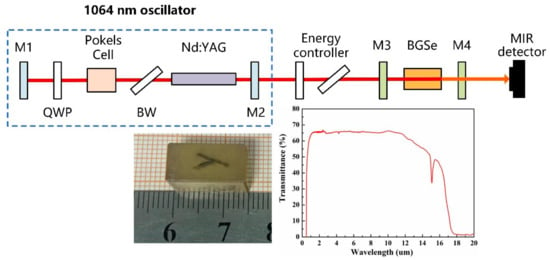
Figure 1.
Schematic of BaGa4Se7-OPO. The inset shows the photograph of the BaGa4Se7 crystal and the transmittance curve (Adapted with permission from Ref. [23]. Copyright © 2019, American Chemical Society).
A half wave plate and a Brewster polarizer were combined as an energy attenuator to adjust the pump energy and maintained the polarization direction. An optical isolator was employed to avoid the possible reflected damage to the Nd:YAG laser. The DP-SRO BGSe-OPO was composed of two BaF2 mirror M3 (1.064 μm AR and 1.35–1.65 μm and 3.65–4.50 μm HR) and M4 (3.65–4.50 μm AR and 1.064 μm and 1.35–1.65 μm HR). The DP-SRO configuration can effectively improve the mid-infrared output and reduce the threshold [22].
A large-size BGSe crystal (shown in the inset of Figure 1) with dimensions of 8 mm × 8 mm × 15 mm was used as the nonlinear optical crystal in OPO. The BGSe crystal employed was grown by vertical Bridgman method [23]. In addition, two zone annealing technique was used to improve the optical properties. The BGSe crystal exhibits high transmittance from 0.47 to 18 μm and low absorption coefficient of 0.042 cm−1 at 4 μm. The BGSe crystal was cut at θ = 42.5° and φ = 0° for Type I phase-matching condition (o-ee). Both sides of the BGSe crystal were well-polished and AR-coated for 1.064 μm, 1.3–1.6 μm and 3–5 μm. The crystal was wrapped in indium foil and cooled to 25 °C with brass heat sink to reduce the thermal effect in BGSe crystal. The wavelength of the signal wave was measured by a spectrometer (Agilent, 86142B, Santa Clara, CA, USA), which was used to calculated the wavelength of the generated mid-infrared wave. A dichroic BaF2 mirror (3.65–4.50 μm AR and 1.064 μm and 1.35–1.65 μm HR) was used as the long-wave pass filter. The energy of the generated mid-infrared wave was measured by a mid-infrared energy detector (Newport corporation, 919E-0.1-12-25K, Irvine, CA, USA).
3. Results and Discussion
The input-output characteristics in Q-switched operation are shown in Figure 2. The maximum output energies of 22.0 mJ/pulse, 19.1 mJ/pulse, 17.7 mJ/pulse and 15.1 mJ/pulse were obtained with no saturation when the repetition rates were 100 Hz, 150 Hz, 200 Hz and 250 Hz, respectively. According to the theoretical analysis of transient thermal distribution of repetitively pumped laser by W. Koechner, the temperature in the center of the laser rod increases with the increase of the repetition rate [24]. Serious heat accumulation at higher repetition rate will broaden the fluorescent spectrum and shorten the upper-level lifetime, leading to the decrease of laser output. The higher pump current was not tested to avoid the damage to the Nd:YAG crystal. The lasing thresholds were about 45 A for different repetition rates. The spatial profile of pump beam at the front surface of BGSe crystal was measured as shown in the inset of Figure 2 (linear in spatial dimensions and color scale). The 1064 nm pump beam diameter was 2.5 mm (vertical direction) × 1.0 mm (horizontal direction). The spot size in horizontal direction was shorter than in vertical direction due to the aberration caused by the Brewster polarizer.
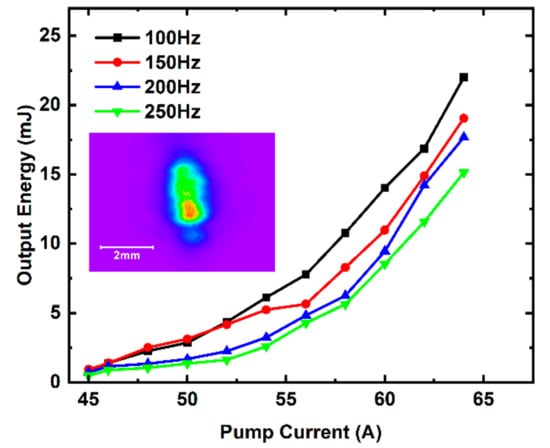
Figure 2.
Input-output characteristics of side-pumped Nd:YAG laser. Inset: spatial profile of pump beam at the front surface of BGSe crystal.
The input-output characteristics of the generated mid-infrared wave at 4.06 μm with different repetition rates are shown in Figure 3a. With the increase of repetition rate, the LIDT decreased rapidly. When the repetition rate was above 150 Hz, damage on the surface of the BGSe crystal was observed with pump energy higher than 9 mJ/pulse (corresponding to peak intensity of about 20 MW/cm2). For higher repetition rate of 500–1000 Hz, optical damages were much more intense, which limited the further improvement in the repetition rate of the BGSe-OPO. The LIDT is lower than our recent report on the low repetition rate (10 Hz) experiment [25]. The thermal effect caused by the extra crystal absorption to the pump wave and the relatively low beam quality from the side-pumped laser were other possible reasons.
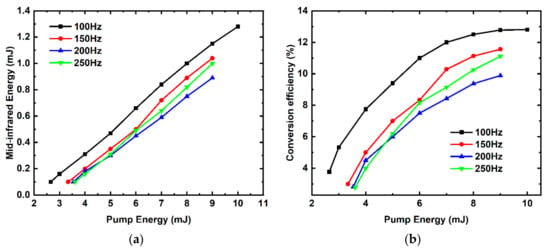
Figure 3.
(a) The input-output characteristics of the BGSe-based DP-SRO with different repetition rate; (b) The conversion efficiency of the BGSe-based DP-SRO with different repetition rate.
The maximum output energy of 1.28 mJ/pulse was achieved at pump energy of 10 mJ/pulse with a repetition rate of 100 Hz. The maximum output average power was 250 mW with a repetition rate of 250 Hz. A slight increase in the OPO threshold was observed with the increase of the repetition rate. The OPO thresholds were measured to be 2.65 mJ/pulse, 3.34 mJ/pulse, 3.54 mJ/pulse and 3.61 mJ/pulse for the repetition rate of 100 Hz, 150 Hz, 200 Hz and 250 Hz, respectively.
Figure 3b shows the conversion efficiencies of the BGSe-OPO with different repetition rates. The maximum conversion efficiency of 12.8% was obtained for the repetition rate of 100 Hz. For different repetition rates of 100 Hz, 150 Hz, 200 Hz and 250 Hz, the slope efficiencies were measured to be 16.4%, 17.0%, 14.4% and 16.6%, respectively. No saturation phenomenon was observed because the low pump peak intensity was limited by the LIDT. Further optimization to pump beam quality could improve the output characteristics of the BGSe-OPO.
The output energy and conversion efficiency of BGSe-OPO decreased with the increase of repetition rate due to the severe thermal effect. It is especially significant for the mid-infrared crystal with poor thermal conductivity like AgGaS2 (1.4 W m−1 K−1), AgGaSe2 (1.0 W m−1 K−1) and BaGa4Se7 (0.56 W m−1 K−1) [11,18]. With low thermal conductivity, the heat absorbed by the crystal from the pump pulse would accumulate because the pulse interval is shorter than the thermal-relaxation time. With the repetition rate increasing, the thermal effect would be more harmful [26]. The thermal diffusivity is 0.502 mm2 s−1 for BGSe crystal along the a crystallographic axis [18], while the thermal diffusion time constant τ is about 376 ms, which is much longer than commonly used mid-infrared crystal, e.g., 5.7 ms for ZGP crystal. The prolonged accumulation of heat would lead to thermal lens effect and thermal dephasing which is unbeneficial to the parametric progress. Improving the cooling structure and a using narrow pump beam with high quality could rapidly reduce the thermal effects in BGSe crystal. The increase of the output energy of OPO at 250 Hz may be the joint result of the thermal focusing effect of Nd:YAG and the stabilization of the thermal effect in BGSe crystal.
The influence of the OPO cavity length to the input-output characteristics were studied at 4.06 μm with the fixed repetition rate at 100 Hz, as shown in Figure 4a. For different cavity lengths of 30 mm, 50 mm and 80 mm, the maximum output energies were 1.28 mJ/pulse, 1 mJ/pulse and 0.87 mJ/pulse, respectively. With the decrease of the cavity length, the transit period of the signal wave in the OPO cavity would decrease, which was beneficial to the interaction between the pump and the signal wave and led to the increase of the mid-infrared output energy.
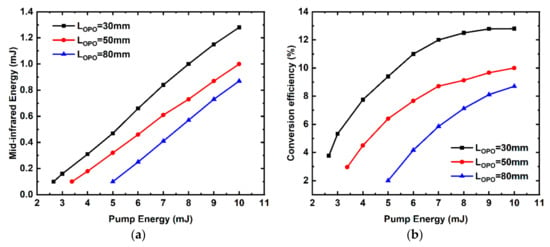
Figure 4.
(a) The input-output characteristics of the BGSe-based DP-SRO with different cavity lengths; (b) The conversion efficiency of the BGSe-based DP-SRO with different cavity lengths.
The OPO thresholds were measured to be 2.65 mJ/pulse, 3.38 mJ/pulse and 5.00 mJ/pulse for the cavity lengths of 30 mm, 50 mm and 80 mm, respectively. The experimental results verify the OPO theory established by S. J. Brosnan and R. L. Byer [22]. With the decrease of the cavity length, the instantaneous cavity net gain increased which leads to the decrease of threshold and the increase of conversion efficiency. The conversion efficiencies of the BGSe-OPO with different cavity lengths were shown in Figure 4b. The maximum conversion efficiency of 12.8% was obtained for the cavity length of 30 mm. For different cavity lengths of 30 mm, 50 mm and 80 mm, the slope efficiencies were measured to be 16.4%, 13.7% and 15.6%. The slope efficiency was measured to be almost constant for each cavity length, which means the back-conversion effect is negligible. With the increase of pump energy, the thermal effect caused by crystal absorption to the pump wave became more serious, causing the decrease of conversion efficiency.
By rotating the BGSe crystal, the tuning range of 3.62–4.10 μm was obtained in the BGSe-OPO. The theoretical wavelength-tuning curves versus the phase-matching angle of Type I BGSe-OPO is calculated based on the Sellmeier equations given in [27]:
The experimental results fit well with the theoretical calculation in Figure 5a. Figure 5b shows the tuning output characteristics of the BGSe-OPO. The tunable output decreased at both sides of the tuning curve due to the increasing pump loss from the Fresnel reflection. The abnormal valley of the tuning curve in Figure 5b around 4.34 μm was deduced to be related to the crystal impurities and defects.
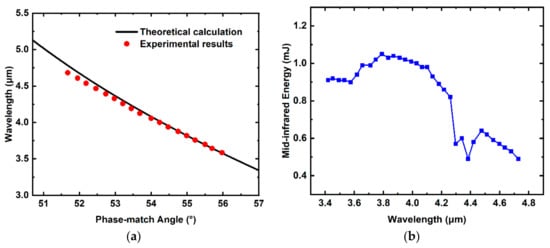
Figure 5.
(a) Comparison of the tuning curve between the experimental and the calculated results; (b) The tuning output characteristics of the BGSe-OPO.
Figure 6 shows the temporal pulse profiles of the pump wave and the mid-infrared wave, measured by Si photodiode (Thorlabs, DET025A/M, Newton, NJ, USA) and (HgCdZn) Te photodiode (Vigo, PCI-9, Ozarow, Mazowiecki, Poland), respectively. With the rapid decline of pump intensity at the trailing edge, the pulse width of the mid-infrared wave (13.6 ns) was measured to be shorter than the pump wave (20.0 ns) [28].
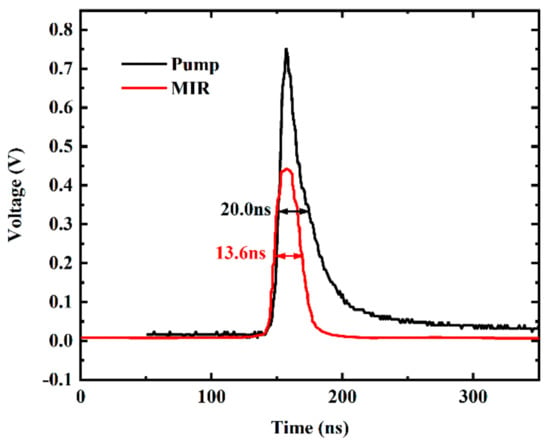
Figure 6.
Comparison of the temporal pulse profiles of the pump wave and the mid–infrared wave.
The spectrum of signal wave at normal incidence was recorded by a spectrometer, as shown in Figure 7. The Gaussian fitted curve has a full width at half maxima (FWHM) of 0.49 nm with a central wavelength of 1442.42 nm. According to the phase-match condition, the FWHM of generated mid-infrared is estimated to be 3.92 nm at 4061 nm, much narrower than the 2 μm pumped degenerate parametric conversion [21].
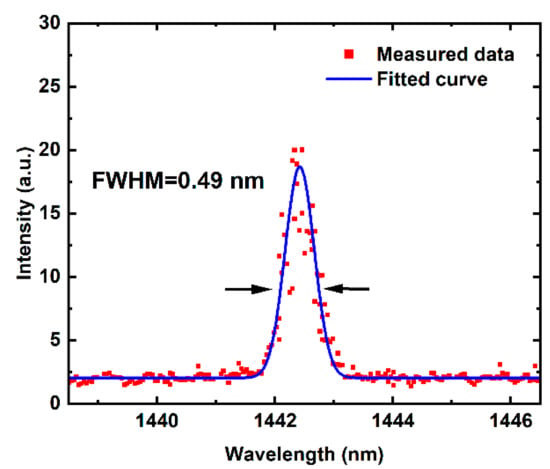
Figure 7.
The signal wave spectrum at normal incidence.
4. Discussion and Conclusions
In this work, a 1064 nm laser pumping, tunable BGSe-OPO was demonstrated. Using a side-pumped electro-optical Q-switched Nd:YAG laser as the fundamental pump source, a tunable mid-infrared wave with high repetition rate up to 250 Hz was generated from BGSe-OPO. DP-SRO configuration was utilized to improve the conversion efficiency and reduce the OPO threshold. The maximum average power of 250 mW was achieved at 4.06 μm, with the OPO cavity length of 30 mm. The influences of the repetition rate and the cavity length were studied experimentally. By rotating the BGSe crystal, tunable mid-infrared output from 3.42–4.73 μm was achieved. The pulse width of the generated mid-infrared wave was measured to be 13.6 ns and the linewidth at 4061 nm was estimated to be 3.92 nm.
The thermal effect of BGSe crystal was observed to be significant, especially in the high repetition rate OPO. Additionally, the accumulation of the thermal effect would result in the decrease of output power and LIDT with the increase of repetition rate, which was harmful to the parametric conversion process. Further optimizations in the pump beam quality, cooling method and cavity structure of DP-OPO would improve the output characteristics of BGSe-OPO.
The BGSe-OPO has advantages in generating the mid-infrared wave with widely tuning range, high power and high repetition rate. Furthermore, BGSe-OPO can be pumped with a 1064 nm laser which is low-cost and usually has a simple structure. BGSe-OPO has the advantages of both the tuning range of ZGP-OPO and the simple structure of PPLN-OPO, which are commonly used in commercial products. The system in this work will show great commercialization potential with the utilization of a commercial 1064 nm laser with a compact size.
Author Contributions
Conceptualization, R.Y. and J.Y. (Jiyong Yao); methodology, D.X.; validation, C.Y., K.C. and Y.H.; formal analysis, Y.W.; investigation, K.Z.; resources, J.Y. (Jiyong Yao); data curation, C.Y.; writing—original draft preparation, K.C.; writing—review and editing, Y.H.; visualization, K.C.; supervision, J.L.; project administration, D.X.; funding acquisition, D.X. and J.Y. (Jianquan Yao). All authors have read and agreed to the published version of the manuscript.
Funding
This research was funded by National Natural Science Foundation of China (NSFC), grant numbers U1837202, 62175182 and 62011540006.
Institutional Review Board Statement
Not applicable.
Informed Consent Statement
Not applicable.
Data Availability Statement
Not applicable.
Conflicts of Interest
The authors declare no conflict of interest.
References
- Sigrist, M. Mid-infrared laser-spectroscopic sensing of chemical species. J. Adv. Res. 2015, 6, 529–533. [Google Scholar] [CrossRef] [PubMed] [Green Version]
- Quagliano, J.; Stoutland, P.; Petrin, R.; Sander, R.; Romero, R.; Whitehead, M.; Quick, C.; Tiee, J.; Jolin, L. Quantitative chemical identification of four gases in remote infrared (9–11 µm) differential absorption lidar experiments. Appl. Opt. 1997, 36, 1915–1927. [Google Scholar] [CrossRef] [PubMed]
- Das, S. Broadly tunable multi-output coherent source based on optical parametric oscillator. Opt. Laser Technol. 2015, 71, 63–67. [Google Scholar] [CrossRef]
- Schunemann, P.; Zawilski, K.; Pomeranz, L.; Creeden, D.; Budni, P. Advances in nonlinear optical crystals for mid-infrared coherent sources. J. Opt. Soc. Am. B 2016, 33, D36–D43. [Google Scholar] [CrossRef]
- Fan, Y.; Eckardt, R.; Byer, R.; Route, R.; Feigelson, R. AgGaS2 infrared parametric oscillator. Appl. Phys. Lett. 1984, 45, 313–315. [Google Scholar] [CrossRef]
- Badikov, V. A HgGa2S4 optical parametric oscillator. Quantum Electon. 2003, 33, 831–832. [Google Scholar] [CrossRef]
- Zondy, J.; Vedenyapin, V.; Yelisseyev, A.; Lobanov, S.; Isaenko, L.; Petrov, P. LiInSe2 nanosecond optical parametric oscillator. Opt. Lett. 2005, 30, 2460–2462. [Google Scholar] [CrossRef]
- Tyazhev, A.; Vedenyapin, V.; Marchev, G.; Isaenko, L.; Kolker, D.; Lobanov, S.; Petrov, P.; Yelisseyev, A.; Starikova, M.; Zondy, J. Singly-resonant optical parametric oscillation based on the wide band-gap mid-IR nonlinear optical crystal LiGaS2. Opt. Mater. 2013, 35, 1612–1615. [Google Scholar] [CrossRef]
- Tyazhev, A.; Kolker, D.; Marchev, G.; Badikov, V.; Badikov, D.; Shevyrdyaeva, G.; Panyutin, V.; Petrov, V. Midinfrared optical parametric oscillator based on the wide-bandgap BaGa4S7 nonlinear crystal. Opt. Lett. 2012, 37, 4146–4148. [Google Scholar] [CrossRef]
- Petrov, V.; Schunemann, P.; Zawilski, K.; Pollak, T. Non critical singly resonant optical parametric oscillator operation near 6.2 microm based on a CdSiP2 crystal pumped at 1064 nm. Opt. Lett. 2009, 34, 2399–2401. [Google Scholar] [CrossRef]
- Yao, J.; Mei, D.; Bai, L.; Lin, Z.; Yin, W.; Fu, P.; Wu, Y. BaGa4Se7: A New Congruent-Melting IR Nonlinear Optical Material. Inorg. Chem. 2010, 49, 9212–9216. [Google Scholar] [CrossRef]
- Yuan, J.-H.; Li, C.; Yao, B.-Q.; Yao, J.-Y.; Duan, X.-M.; Li, Y.-Y.; Shen, Y.-J.; Wu, Y.-C.; Cui, Z.; Dai, T.-Y. High power, tunable mid-infrared BaGa4Se7 optical parametric oscillator pumped by a 2.1 μm Ho: YAG laser. Opt. Express 2016, 24, 6083–6087. [Google Scholar] [CrossRef]
- Yang, F.; Yao, J.; Xu, H.; Feng, Y.; Yin, W.; Li, F.; Yang, J.; Du, S.; Peng, Q.; Zhang, J.; et al. High efficiency and high peak power picosecond mid-infrared optical parametric amplifier based on BaGa4Se7 crystal. Opt. Lett. 2013, 38, 3903–3905. [Google Scholar] [CrossRef]
- Kostyukova, N.; Boyko, A.; Badikov, V.; Badikov, D.; Shevyrdyaeva, G.; Panyutin, V.; Marchev, G.; Kolker, D.; Petrov, V. Widely tunable in the mid-IR BaGa4Se7 optical parametric oscillator pumped at 1064 nm. Opt. Lett. 2016, 41, 3667–3670. [Google Scholar] [CrossRef]
- Xu, D.; Zhang, J.; He, Y.; Wang, Y.; Yao, J.; Guo, Y.; Yan, C.; Tang, L.; Li, J.; Zhong, K.; et al. High-energy, tunable, long-wave mid-infrared optical parametric oscillator based on BaGa4Se7 crystal. Opt. Lett. 2020, 45, 5287–5290. [Google Scholar] [CrossRef]
- Yang, F.; Yao, J.; Guo, Y.; Yuan, L.; Bo, Y.; Peng, Q.; Cui, D.; Yu, Y.; Xu, Z. High-energy continuously tunable 8–14 μm picosecond coherent radiation generation from BGSe-OPA pumped by 1064 nm laser. Opt. Laser Technol. 2020, 125, 106040. [Google Scholar] [CrossRef]
- Zhang, Y.; Zuo, Y.; Li, Z.; Wu, B.; Yao, J.; Shen, Y. High energy mid-infrared laser pulse output from a BaGa4Se7 crystal-based optical parametric oscillator. Opt. Lett. 2020, 45, 4595–4598. [Google Scholar] [CrossRef]
- Yao, J.; Yin, W.; Feng, K.; Li, X.; Mei, D.; Lu, Q.; Ni, Y.; Zhang, Z.; Hu, Z.; Wu, Y. Growth and characterization of BaGa4Se7 crystal. J. Cryst. Growth 2012, 346, 1–4. [Google Scholar] [CrossRef]
- Kostyukova, N.; Boyko, A.; Erushin, E.; Kostyukov, A.; Badikov, V.; Badikov, D.; Kolker, D. Laser-induced damage threshold of BaGa4Se7 and BaGa2GeSe6 nonlinear crystals at 1.053 μm. J. Opt. Soc. Am. B 2020, 37, 2655–2659. [Google Scholar] [CrossRef]
- Yang, K.; Liu, G.; Li, C.; Yao, B.; Yao, J.; Chen, Y.; Mi, S.; Duan, X.; Dai, T. Research on performance improvement technology of a BaGa4Se7 mid-infrared optical parametric oscillator. Opt. Lett. 2020, 45, 6418–6421. [Google Scholar] [CrossRef]
- Liu, G.; Chen, Y.; Li, Z.; Yang, K.; Yao, B.; Yao, J.; Wang, R.; Yang, C.; Mi, S.; Dai, T.; et al. High-beam-quality 2.1 µm pumped mid-infrared type-II phase-matching BaGa4Se7 optical parametric oscillator with a ZnGeP2 amplifier. Opt. Lett. 2020, 45, 3805–3808. [Google Scholar] [CrossRef]
- Brosnan, S.; Byer, R. Optical parametric oscillator threshold and linewidth studies. IEEE J. Quantum Elect. 1979, 15, 415–431. [Google Scholar] [CrossRef] [Green Version]
- Guo, Y.; Li, Z.; Lei, Z.; Luo, X.; Yao, J.; Yang, C.; Wu, Y. Synthesis, Growth of crack-free large-size BaGa4Se7 crystal, and annealing studies. Cryst. Growth Des. 2019, 19, 1282–1287. [Google Scholar] [CrossRef]
- Koechner, W. Transient thermal profile in optically pumped laser rods. J. Appl. Phys. 1973, 44, 3162–3170. [Google Scholar] [CrossRef]
- He, Y.; Guo, Y.; Xu, D.; Wang, Y.; Zhu, X.; Yao, J.; Yan, C.; Tang, L.; Li, J.; Zhong, K.; et al. High energy and tunable mid-infrared source based on BaGa4Se7 crystal by single-pass difference-frequency generation. Opt. Express 2019, 27, 9241–9249. [Google Scholar] [CrossRef]
- Tucker, J.; Marquardt, C.; Bowman, S.; Feldman, B. Transient thermal lens in a ZnGeP2 crystal. Appl. Optics 1995, 34, 2678–2682. [Google Scholar] [CrossRef]
- Yang, F.; Yao, J.; Xu, H.; Zhang, F.; Zhai, N.; Lin, Z.; Zong, N.; Peng, Q.; Zhang, J.; Cui, D.; et al. Midinfrared optical parametric amplifier with 6.4–11 μm range based on BaGa4Se7. IEEE Photonics Technol. Lett. 2015, 27, 1100–1103. [Google Scholar] [CrossRef]
- Kolker, D.; Kostyukova, N.; Boyko, A.; Badikov, V.; Bsdikov, D.; Shadrintseva, A.; Tretyakova, N.; Zenov, K.; Karapuzikov, A.; Zondy, J. Widely tunable (2.6–10.4 μm) BaGa4Se7 optical parametric oscillator pumped by a Q-switched Nd:YLiF4 laser. J. Phys. Commun. 2018, 2, 035039. [Google Scholar] [CrossRef]
Publisher’s Note: MDPI stays neutral with regard to jurisdictional claims in published maps and institutional affiliations. |
© 2022 by the authors. Licensee MDPI, Basel, Switzerland. This article is an open access article distributed under the terms and conditions of the Creative Commons Attribution (CC BY) license (https://creativecommons.org/licenses/by/4.0/).